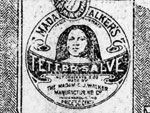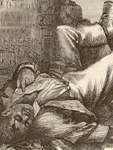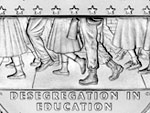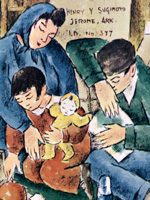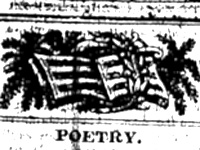Slavery, legally sanctioned in the south, and for a long time in the north as well, was supported at every turn by legal structures. So, something that I like to use a lot in teaching, just to get students thinking about this, are—these are receipts, these are receipts. And, the one I'm holding right now is dated Norfolk, September 17, 1853. It's a printed receipt that's been filled out. It's something that, it's very similar in a way, to something that you might buy at an office supply store. If you went and needed a book of receipts because, you know, you had a business.
It's got a blank space that you can fill in the place and date. And then it says 18-five and blank.
So just like today in writing a check you might have—or a set of receipts—just to make things easier they might write two-zero-zero and then you can put in 2009, or 2008, or something like that. Just to make it just a little easier in filling out a receipt. It's got this, it's for—it's obviously a book of receipts that you can fill out all through the 1850s. Then it says, "Received of 'blank,' 'blank' dollars, being in full for the purchase of 'blank' Negro slave named 'blank.' The right and title of said slave 'blank' warrant and defend against the claims of all persons whatsoever, and likewise warrant 'blank' sound and healthy, as witness my hand and seal," and then the title of this. And it's a very elegant 19th-century receipt. It's in a nice filigreed kind of handwriting, it's got lovely illustrations on the side that depict kind of the engines of commerce for the time. There's a steamboat and there's a clipper ship and there's a railroad.
And it says, "Murphy and Company, Printers, Baltimore." Thinking about it, how many people are involved in this receipt? It's been printed by a printer in Baltimore, but it's been printed for probably a lot of people. But, this one in particular, it's noted it's sold by a bookseller in Richmond. This particular receipt is dated in Norfolk.
Now, if you were teaching students, using this for the classroom, one of the first things you might want to do is list all of the locations that are on this receipt and any of the other receipts, you know, so that students get a sense of the geography of the place. Like, where is Baltimore in relationship to Richmond? Where is Norfolk and why might this receipt be dated in Norfolk?
The thing, as an historian, that strikes me about these documents is, first, how mundane they are, how banal they are, how similar they are to the kinds of—the book of receipts that you could pick up today. But then, to realize that the people that are kind of in this kind of elegant handwriting, that are signing their names to this receipt, are engaged in the sale of humans.
This particular receipt from Baltimore, dated in 1851, "warrants and defends against the claims of all persons whatsoever and likewise warrants sound and healthy and slaves for life." So, it's almost identical, but it adds the little phrase "and slaves for life," that none of the others do. So, you ask yourself, "Well, what might account for that little bit of fine print, that little legal boilerplate being added to this receipt?"
People keep records of property in a way that they don't keep of people, and they lay—these records stay around with us for a long time.
You often will hear that, well, the Emancipation Proclamation didn't free any slaves really, because it only was under effect for those areas that weren't under the control of the Union Army. But what it did do, was take this huge amount of capital that was vested in slaves and wiped it out. It just erased billions of dollars of capital. It's one of the reasons that New York City was such a hotbed of pro-slavery sentiment, because the banks and the trading houses in New York City were very invested economically.
We know that, in this particular one, "Received of Charles H. Shield, Esquire, 1,000 dollars, being paid in full for the purchase of a Negro slave named Mary and her child, Louisianna. The right and title of said slave, I warrant and defend against the claims of all persons whatsoever," and it's signed by William W. Hall. So, Charles Shield and William Hall are engaged in the transaction of Mary and her child. But this is a legal document. Think about what is the backing? What is the legal claim that this receipt gives to the bearer? So that there's a certain#&8212;in other words, it's kind of to demonstrate that I have the legal right that I've been given by the seller, to the ownership of Mary and her child. The other thing, of course, you keep receipts for, is in case you have to return something.
It's very similar when you think about it, to the kinds of promises that you make when you're buying anything. Here—there's a warrant. In other words, someone is making a kind of authoritative claim and "defend against all claims of all persons whatsoever." So, by that, in other words that, "I have legal title to these people, and I warrant, I signed this in warrant that in fact, I'm transferring that title to the bearer, and I likewise warrant them sound and healthy, as witnessed by hand and seal." So, they're making a claim about these people, and it's not surprising that they make a claim about this. As I said, the law is imbued in every aspect of slavery, including all of these kinds of transfers, these kind of transfers, the sale of slaves. And there's a whole kind of, a set of legal laws about, "Well, what would happen if you sold a slave to someone, and the slave died? What if the person knew that they were ill? So, what does it mean to say that someone is healthy?" and what, what are the kinds of—these things come up. The courts serve the function of making sure that the business of slavery proceeds in an orderly fashion.
This is all about the buying and selling of people. But, there's this huge set of laws that are protecting every transaction. So, a lot of this printed language is what a lot of people, they'll refer to it as "boilerplate." This is the fine print, the fine print of the sale of slaves, that has a special meaning for every jurisdiction that this receipt is made out in.
The state, whether it's Virginia here or elsewhere, does have an interest in knowing about this, in part, just to keep track, but also because these transactions are often—they'll say "paid in full," but they're really also backed by loans. People are buying slaves on credit. It's very speculative. So, there are banks, insurance companies, who also have a stake in the ownership of Mary and her child, Louisiana, that may go far beyond Norfolk and the environs.
Now, one thing that this document won't tell you is, in and of itself, and I can't say that I know the answers to this myself, but who William Hall and Charles Shield are, but you can kind of make some educated guesses. This is happening, the sale is recorded in Norfolk, Virginia. Norfolk is, it's on the coast. It's 1853. Virginia is an old part of the kind of slave south of the Chesapeake [region]. There are hundreds of thousands of enslaved people in Virginia. But, the real money in 1853 to be made in slavery, is not in Virginia. It's in the new southwest. It's in places like Louisiana and Alabama, Mississippi.
A lot of legal cases developed over this because people wanted to make sure they were getting maximized profits for the sale of the estate, including slaves. It was found that "items sell best when sold separately." In other words, given the opportunity to sell a family, self-contained as a lot, to an individual, or to sell them as individuals, more money would be made selling them as individuals.
And, because the courts have a fiduciary responsibility in making sure that the heirs get the best bargain that they can from the estate, they're mandated to sell separately. So, it reminds one that there are hundreds of thousands of families that are being broken up through these types of trade. It's also a good thing to stop and think about how often we talk about the transatlantic slave trade, but to consider the domestic slave trade as well, as being a great tragedy and something that continued to wreak havoc for years and years. Some of the saddest documents that one can find are in African American newspapers and magazines, sometimes 10, 20 years after the Civil War. They're often called "Information Wanted" notices, looking for a mother or a sister or a child, still trying to find their family members.

